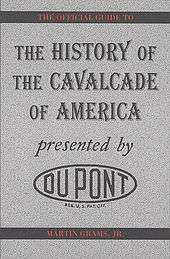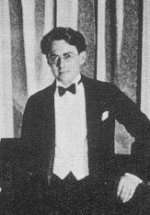Cavalcade of America
|
Musical director Donald Voorhees (1935-41, 1949-53) | |
| Genre | Anthology drama |
|---|---|
| Running time | 25 minutes |
| Country | United States |
| Language(s) | English |
| Home station |
CBS (10/09/35-05/29/39) NBC (01/02/40-03/31/53) |
| TV adaptations |
NBC (10/01/52-09/02/53) ABC (09/29/53-06/21/55) ABC (09/06/55-06/04/57) |
| Hosted by | Walter Huston (09/18/44-02/12/45) |
| Starring | Numerous Broadway and Hollywood stars |
| Created by | Roy Durstine |
| Written by |
Arthur Miller Norman Rosten Robert Tallman Peter Lyon Robert Richards Stuart Hawkins Arthur Arent Edith Sommer Halsted Welles Henry Denker Priscilla Kent Virginia Radcliffe Frank Gabrielson Margaret Lewerth Morton Wishengrad George Faulkner Irve Tunick |
| Directed by |
Robert Stevenson (director) Laslo Benedek Peter Godfrey (director) John Brahm William A. Seiter Harry Horner Kenneth Webb Homer Fickett Bill Sweet Homer Fickett Jack Zoller |
| Produced by |
Arthur Pryor Louis Mason Larry Harding Homer Fickett Jack Zoller Roger Pryor H.L. Blackburn |
| Air dates | October 9, 1935 to March 31, 1953 |
| No. of series | 18 |
| No. of episodes | 781 |
| Audio format | Monaural sound |
| Opening theme |
"March Theme" "Glory of America" |
Cavalcade of America is an anthology drama series that was sponsored by the DuPont Company, although it occasionally presented musicals, such as an adaptation of Show Boat,[1] and condensed biographies of popular composers. It was initially broadcast on radio from 1935 to 1953, and later on television from 1952 to 1957. Originally on CBS, the series pioneered the use of anthology drama for company audio advertising.
Cavalcade of America documented historical events using stories of individual courage, initiative and achievement, often with feel-good dramatizations of the human spirit's triumph against all odds. The series was intended to improve DuPont's public image after World War I. The company's motto, "Maker of better things for better living through chemistry," was read at the beginning of each program, and the dramas emphasized humanitarian progress, particularly improvements in the lives of women, often through technological innovation.
Background
The show started as part of a successful campaign to reinvigorate DuPont. In the early 1930s, the Nye Committee investigations concluded that DuPont had made a fortune profiteering in World War I. The company stood accused of encouraging an arms race between World War I enemies, after being heavily subsidized by the Allies to increase black powder production. The negative effects of the investigation left the company demoralized, directionless and with a tarnished corporate image in the middle of the Great Depression.
DuPont's products were primarily not for public consumption, so there was no purpose in promoting them through advertising. As a solution to DuPont's troubles, Roy Durstine, then creative director of Batten, Barton, Durstine & Osborn, proposed the creation of Cavalcade of America using the company motto. This was to be an important element in the successful re-branding of DuPont as an American legacy engaged in making products for the well-being of Americans and humanity in general.
Content
DuPont's image problems led the company to promote some pacifist and socialist ideals. DuPont stipulated several topics would be taboo on the show, such as gunfire of any kind, which attracted writers such as Norman Rosten and Arthur Miller, who had signed the Oxford Pledge while at University of Michigan. For scripts, the program was also able to attract such prominent writers as Maxwell Anderson, Stephen Vincent Benét, Carl Sandburg and Robert Sherwood. Although Yale University historian Frank Monaghan signed on as an advisor to ensure historically accuracy of the scripts, listeners were quick to point out anachronisms; trains did not use air brakes in 1860 and Washington's troops could not have sung "Tannenbaum" while crossing the Delaware since it was written two months after that event.
Cast
This is the cast listing according to The Concise Encyclopedia of American Radio.[2]
Narrator Walter Huston
Actors:
- Ray Collins
- Ted de Corsia
- Kenny Delmar
- Ross Elliott
- Cary Grant
- Gary Gray
- Edwin Jerome
- Ted Jewett
- Raymond Edward Johnson
- Bill Johnstone (actor)
- John McIntire
- Agnes Moorehead
- Jeanette Nolan
- Tyrone Power
- Frank Readick
- Ronald Reagan
- Stafford Repp
- Mickey Rooney
- Luis van Rooten
- Everett Sloane
- Jack Smart
- Paul Stewart
- Karl Swenson
- Orson Welles
Advertising
Cavalcade of America made a major impact in radio advertising during its run on the air. DuPont, a chemical corporation that did not sell public goods, sponsored Cavalcade of America and integrated their company slogan and agenda into the inspirational and pro-American achievement themes of each episode.[3]
After DuPont’s war profits were revealed to be in the billions and the company’s stock nearly quadrupled, the American public saw DuPont negatively as one of the “merchants of death” after World War I. This forced Cavalcade of America to fall in line with avoiding the use of many radio cliches of the day, including gunfire and depicting blacks on the radio. The writers of Cavalcade of America supported this move by DuPont, as the staff was made up of mainly young academics that were either pacifists or signed an anti-war pledge in college. With new writers and a world-class PR firm, DuPont was able to shake the “merchant of death” label and remained a sponsor for a top radio program.[4]
Cavalcade of America was an early exercise in corporate image-building. DuPont promoted itself as a hero for America. This type of propaganda was shrewd but effective; it put a corporate image behind the real-life heroes that lived a century before. One way DuPont was able to emphasize its own products in episodes of Cavalcade of America was by having health-related episodes that promoted the use of chemical-compound products manufactured by DuPont. This was not necessarily advertising, since individuals could not go to the store and purchase these chemical items.[3]
According to DuPont public relations executives, the goal was not to directly sell their products, but rather to explain the company’s goals and foster the confidence, respect and goodwill of the public. By recreating little-known events in the lives of historically-respected Americans through dramatizations, Cavalcade of America caused listeners to associate DuPont’s products with patriotism and self-reliance. The series also gave history and chemistry more prestige than it would have otherwise had. By making the show thrilling, but not over-sensationalized, DuPont was able to better its own branding and get away from being perceived as a military-only company.[5]
Nylon show
On May 15, 1940 DuPont made nylon women's hosiery available to the public and began an advertising blitz. The day was designated "N-day" by DuPont's marketeers, and an entire episode of Cavalcade of America was markedly different: DuPont selected a "typical" housewife to interview G.P. Hoff, Director of Research of DuPont's Nylon Division. In the rigged interview, Hoff expounded at length on the virtues of nylon. Eager to purchase nylon hose, thousands of women waited in lines for department stores to open the following morning. 750,000 nylons had been manufactured for N-Day, but all were sold on the first day they went on sale.
Television
In the 1950s, DuPont switched its advertising strategy from radio to television, and Cavalcade of America became a television series through Gene Autry's Flying A Productions.[6] One hundred and thirty-three episodes were aired over five seasons between 1952 and 1957. During a six-month period, the television and radio series overlapped. The show was telecast on both NBC (1952–53) and ABC (1953–57). It was renamed DuPont Cavalcade Theater in August 1955, and it was known as DuPont Theater during its last year. In the 1957 fall season, it was replaced by The DuPont Show of the Month, a 90-minute live dramatization of popular novels and short stories or abridged versions of films and plays. That series ran until 1961. In one of the episodes Hal Stalmaster portrayed a youthful Bob Richards, the Olympic athlete. Major League Baseball player Jackie Jensen appeared as himself, with Vivi Janiss as his mother, in "The Jackie Jensen Story", which aired on April 17, 1956.
Many kinescopes of Cavalcade of America survive at the UCLA Film and Television Archive.
Books

During the late 1930s, Dixon Ryan Fox and Arthur Meier Schlesinger edited a series of books based on the series published by Milton Bradley. In 1956, the series was adapted into a book, Cavalcade of America: The Deeds and Achievements of the Men and Women Who Made Our Country Great, published by Crown. Chapters covered such historical figures as Abraham Lincoln, telegraph organizer Hiram Sibley, engineer James Eads, John Quincy Adams fighting the gag rule and Clara Barton's career that led her to head the American Red Cross. Martin Grams, Jr.'s The History of the Cavalcade of America (Morris Publishing, 1998) features episode guides for both the radio and TV series.
See also
Notes
- ↑ "Archived copy". Archived from the original on 2011-07-26. Retrieved 2011-02-03.
- ↑ Christopher H. Sterling; Cary O'Dell, eds. (2011). "Cavalcade of America". The Concise Encyclopedia of American Radio. p. 135.
- 1 2 Cavalcade of America. Newspaper Heroes on the Air.
- ↑ The Cavalcade of America: Examining the Myth and Reality of Hero Worship in American Radio.
- ↑ Marchand, R. (2001). Creating the Corporate Soul: The Rise of Public Relations and Corporate Imagery in Big Business. Pages 220-223.
- ↑ "Flying A Productions". Internet Movie Data Base. Retrieved August 1, 2014.
References
- Blue, Howard (2002). Words at War: World War II Era Radio and the Postwar Broadcasting Industry Blacklist. Lanham, Maryland:Scarecrow Press. ISBN 0-8108-4413-3
- Godfrey, Donald G.; Leigh, Frederic A. (1998). Historical Dictionary of American Radio. Westport, CT: Greenwood Press. ISBN 0-313-29636-7.
- Grams, Martin (1998). The History of the Cavalcade of America. Kearney, NE: Morris Publishing. ISBN 0-7392-0138-7.
- Gregory, James R.; Wiechmann, Jack G. (1999). Marketing Corporate Image. Lincolnwood, IL: NTC Business Books. ISBN 0-8442-3307-2.
- Horten, Gerd (2003). Radio Goes to War: The Cultural Politics of Propaganda During World War II. Berkeley, CA; London: University of California Press. ISBN 0-520-24061-8.
- "Radio Broadcast Log: Cavalcade Of America". Audio Classics Archive. Retrieved 2007-03-10.
Further reading
- William L. Bird, Jr. "Better Living": Advertising, Media, and the New Vocabulary of Business Leadership, 1935-1955. Evanston, IL: Northwestern University Press, 1999.
External links
- Jerry Haendiges Vintage Radio Logs: Cavalcade of America
- University of Virginia: American Studies: Cavalcade of America
- Photograph archive related to the Cavalcade of America at the Hagley Library
- List of Cavalcade of America episodes at the Internet Movie Database
- Cavalcade of America, Museum of Broadcast Communications
- Company Voice Advertising, Museum of Broadcast Communications
- Cavalcade of America at CVTA
Listen to
- Cavalcade of America in The Internet Archive's Old-Time Radio Collection
- OTR.Network Library, Cavalcade of America
- Outlaws Old Time Radio Corner, Cavalcade of America
